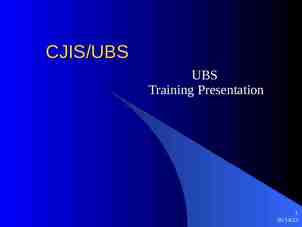Title I, Part A: Targeted Assistance Schools and Schoolwide
26 Slides268.19 KB
Title I, Part A: Targeted Assistance Schools and Schoolwide Programs April 15, 2020
Technology Logistics Please mute your microphone Please turn off your web cam Ask questions in the chat function Sessions will be recorded and posted
Future Sessions and Resources A link to the Session List/Virtual Conference Information document is embedded in the email you received on April 9th This document, as well as resources, templates and guidance referenced during sessions, can be found on the AOE website: – Go to education.vermont.gov – In the left-hand sidebar, click on 1. “Student Support” 2. “Federal Programs Under ESSA” 3. “Consolidated Federal Programs”
Session Outcomes By the end of this session, participants will be able to: – distinguish between a Title I targeted assistance school (TAS) and a schoolwide program (SWP) – understand the benefits of both a Title I targeted assistance school (TAS) and a schoolwide program (SWP)
Session Outcomes Continued – be able to determine if a school is eligible to operate a Title I targeted assistance school (TAS) or a schoolwide program (SWP) – be able to maximize the services and resources to help ensure that students meet the challenging state academic standards
Purpose of Title I, Part A To provide all children significant opportunity to receive a fair, equitable, and high quality education, and to close achievement gaps.
Title I, Part A Allowable Activities Supplemental instruction for eligible learners – personnel, materials, assessments, and technology Extended School Day/Extended Year Programs Professional Learning related to Title I programming Preschool services – beyond the state required 10 hours per week
Title I, Part A Allowable Activities Services for students experiencing homelessness Parent and Family Engagement activities Non-academic services that impact student performance, e.g. school climate, behavior, social-emotional health, and attendance
What are Targeted Assistance Schools? Those students most at-risk to not meet state standards, per local criteria that is objective, includes multiple measures and is uniformly applied This includes students who are: – homeless – migrant – in foster care – served by an institution for neglected or delinquent students
What are Targeted Assistance Schools? “Title I caseload” Section 1115 of ESSA
What are Schoolwide Programs? Upgrades the entire educational program of a school Serves all students and teachers within that particular school Section 1114 of ESSA
Eligibility Requirements Targeted Assistance Schools Schools that are above the district poverty average or have a low-income of 35% or greater Schoolwide Programs Schools with 40% or greater low-income (unless the school receives a waiver from the state) Schools may still choose to be Targeted Assistance Programs
Which Students Receive Services? Targeted Assistance Schools Funds are used only for identified students to receive services, “caseload” Schoolwide Programs Funds are used to upgrade the entire educational program, serving all students
Identification of Students Targeted Assistance Schools Student identification is made that renders them eligible or ineligible for services Schoolwide Programs No student identification is made that renders them eligible or ineligible for services Students identified as most at risk may be given additional assistance
Which Teachers/Staff Benefit? Targeted Assistance Schools May provide professional development to staff who provide direct support to Title I students and is aligned with these students’ needs Schoolwide Programs May provide professional development for all staff to support all students
What Funds Are Used? Targeted Assistance Schools Title I, Part A funds only Schoolwide Programs Title I, Part A funds can be consolidated with other Federal, State, and local funds
Benefits of a Targeted Assistance School Focus is on those eligible students who are identified by the school as failing, or most at risk of failing, to meet the challenging state academic standards Not restricted to only students who are economically disadvantaged
Benefits of Consolidating Funds in a Schoolwide Program Flexibility to allocate all available resources effectively and efficiently May aid in short comings/limited resources A school is not required to meet most of the statutory and regulatory requirements of pooled formula Federal programs, provided it meets the intent and purposes of those programs
Benefits of Consolidating Funds in a Schoolwide Program May help with meeting Title IV budgeting requirements – LEAs with an allocation of less than 30,000 are only required to meet one of the three budgeting requirements When consolidating, the funds are not proportional (dollar for dollar) to the original funding source
Which Funds Can Be Consolidated? All federal education funds—formula and discretionary/competitive administered by the U.S. DOE* State and Local funds, unless not allowed *Additional requirements for: IDEA, Indian Education (Title VI), 21st Century (Title IVB), Migrant Education (Title IC), and English Language Acquisition (Title III)
Common Funds Consolidated into a Schoolwide Program Title I only Title I and Title II Title I, Title II, and Title IV
What To Consider – Targeted Assistance Schools What does the school’s number of at-risk students look like? Must show that funds otherwise received from non-Title I sources are not replaced with Title I funds.
What To Consider – Schoolwide Programs What funds are going to be consolidated? Are the same funds being consolidated across all the schools who wish to operate a schoolwide program within the LEA? Are there investments the represent each of the funding sources consolidated into the schoolwide program?
Closing Remarks Targeted Assistance Schools Schoolwide Programs
Questions
Contact Information For questions regarding Title I, Part A and Schoolwide Programs please contact: Kristine Seipel State Title I Director 802-828-1447 [email protected]































